2013 Hyundai Sonata Hybrid hybrid system warning
[x] Cancel search: hybrid system warningPage 249 of 425
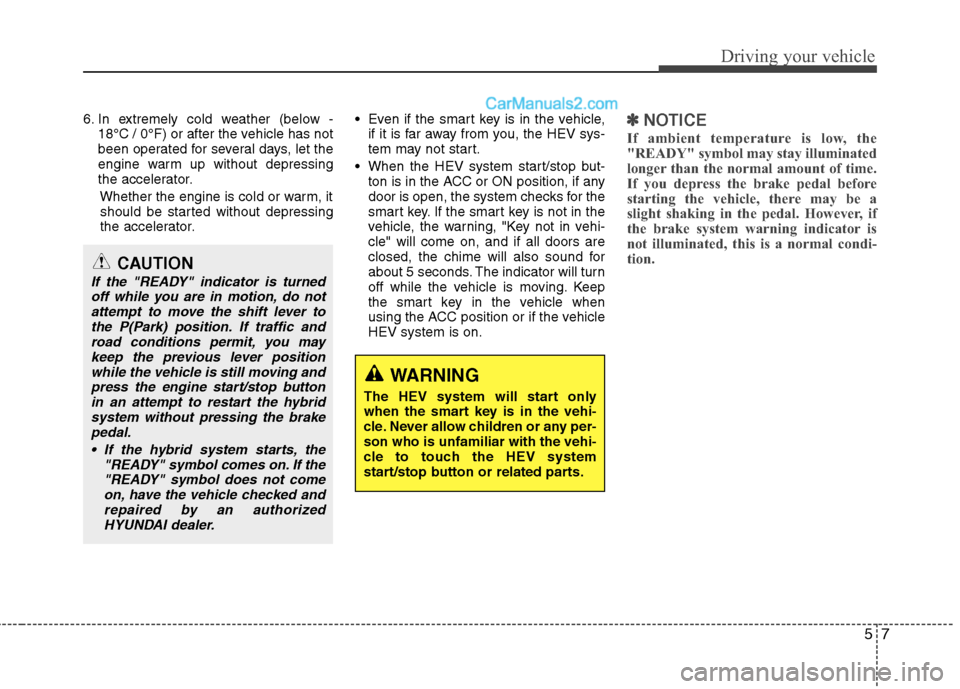
57
Driving your vehicle
6. In extremely cold weather (below -
18°C / 0°F) or after the vehicle has not
been operated for several days, let the
engine warm up without depressing
the accelerator.
Whether the engine is cold or warm, it
should be started without depressing
the accelerator.Even if the smart key is in the vehicle,
if it is far away from you, the HEV sys-
tem may not start.
When the HEV system start/stop but-
ton is in the ACC or ON position, if any
door is open, the system checks for the
smart key. If the smart key is not in the
vehicle, the warning, "Key not in vehi-
cle" will come on, and if all doors are
closed, the chime will also sound for
about 5 seconds. The indicator will turn
off while the vehicle is moving. Keep
the smart key in the vehicle when
using the ACC position or if the vehicle
HEV system is on.✽ ✽
NOTICE
If ambient temperature is low, the
"READY" symbol may stay illuminated
longer than the normal amount of time.
If you depress the brake pedal before
starting the vehicle, there may be a
slight shaking in the pedal. However, if
the brake system warning indicator is
not illuminated, this is a normal condi-
tion.
WARNING
The HEV system will start only
when the smart key is in the vehi-
cle. Never allow children or any per-
son who is unfamiliar with the vehi-
cle to touch the HEV system
start/stop button or related parts.
CAUTION
If the "READY" indicator is turned
off while you are in motion, do not
attempt to move the shift lever to
the P(Park) position. If traffic and
road conditions permit, you may
keep the previous lever position
while the vehicle is still moving and
press the engine start/stop button
in an attempt to restart the hybrid
system without pressing the brake
pedal.
If the hybrid system starts, the
"READY" symbol comes on. If the
"READY" symbol does not come
on, have the vehicle checked and
repaired by an authorized
HYUNDAI dealer.
Page 257 of 425

515
Driving your vehicle
In the event of brake failure
If service brakes fail to operate while the
vehicle is in motion, you can make an
emergency stop with the parking brake.
The stopping distance, however, will be
much greater than normal.
✽ ✽
NOTICE
1) When you apply the brake repeatedly,
you may hear the sound the electric
hydraulic pump or motor operating.
This is a normal condition.
2) The following types of pedal applica-
tions may result in the brake pedal
feeling different, however it is normal
condition.
- When you apply the pedal quickly
- When you apply the pedal continu-
ously and repeatedly
- While braking, when the ABS oper-
ated
(Continued)
Wet brakes may impair the vehi-
cle’s ability to safely slow down;
the vehicle may also pull to one
side when the brakes are applied.
Applying the brakes lightly will
indicate whether they have been
affected in this way. Always test
your brakes in this fashion after
driving through deep water. To
dry the brakes, apply them lightly
while maintaining a safe forward
speed until brake performance
returns to normal.
Always, confirm the position of
the brake and accelerator pedal
before driving. If you don't check
the position of the accelerator
and brake pedal before driving,
you may depress the accelerator
instead of the brake pedal. It may
cause a serious accident.
Do not turn off the Hybrid system
while going down a hill. The brake
booster may not work sufficiently
and the braking distance may be
longer.
(Continued)(Continued)
If the brake pedal does not return
to its normal position when
released, there may be a malfunc-
tion in the brake system. Take
your vehicle to an authorized
HYUNDAI dealer and have the
system checked.
To avoid applying the brakes do
not get too close to the vehicle in
front of you and try to avoid
going down steep roads or sharp
corning if the power assisted
brakes are not functioning nor-
mally. The vehicle will stop but
the braking distance may be
longer.
WARNING- Parking brake
Applying the parking brake while
the vehicle is moving at normal
speeds can cause a sudden loss of
control of the vehicle. If you must
use the parking brake to stop the
vehicle, use great caution in apply-
ing the brake.
CAUTION
If the driver’s door is not firmly
closed, the auxiliary battery may be
discharged because the brake con-
troller remains in standby opera-
tion. To prevent the battery from
being discharged, ensure the door
is fully closed.
Page 259 of 425

517
Driving your vehicle
If the parking brake does not release or
does not release all the way, have the
system checked by an authorized
HYUNDAI dealer.
Check the brake warning light by pressing
the engine start/stop button ON (do not
start the engine). This light will be illumi-
nated when the parking brake is applied
with the engine start/stop button in the
START or ON position.
Also, the brake warning light may illumi-
nate for a second even though the park-
ing brake is released at the moment the
engine start/stop button is pressed to the
ON position.
Before driving, be sure the parking brake
is fully released and the brake warning
light is off.
If the brake warning light remains on after
the parking brake is released while the
hybrid system is in READY state, there
may be a malfunction in the brake sys-
tem. Immediate attention is necessary.If at all possible, cease driving the vehicle
immediately. If that is not possible, use
extreme caution while operating the vehi-
cle and only continue to drive the vehicle
until you can reach a safe location or
repair shop.
WARNING
To prevent unintentional move-
ment when stopped and leaving
the vehicle, do not use the
gearshift lever in place of the
parking brake. Set the parking
brake AND make sure the
gearshift lever is securely posi-
tioned in P (Park) for automatic
transaxle equipped vehicles.
Never allow anyone who is unfa-
miliar with the vehicle to touch
the parking brake. If the parking
brake is released unintentionally,
serious injury may occur.
All vehicles should always have
the parking brake fully engaged
when parking to avoid inadver-
tent movement of the vehicle
which can injure occupants or
pedestrians.
W-75
WARNING
It is normal for the brake warning
light to illuminate temporarily
when the brake is depressed
repeatedly and go out after a few
seconds when the brake is no
longer depressed. However, if the
brake warning light turns on, this
may be a sign of a malfunctioning
brake system and could cause
the braking distance to increase.
Have your system checked if the
brake warning light remains on. A
malfunctioning brake system
could result in a vehicle accident
and serious injury or death.
Page 289 of 425
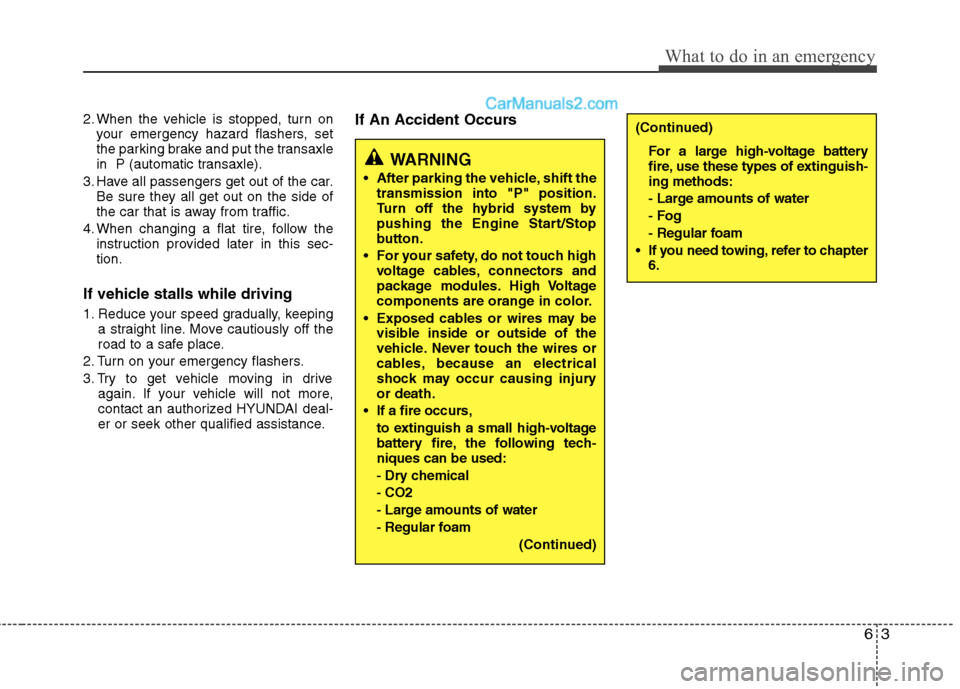
63
What to do in an emergency
2. When the vehicle is stopped, turn on
your emergency hazard flashers, set
the parking brake and put the transaxle
in P (automatic transaxle).
3. Have all passengers get out of the car.
Be sure they all get out on the side of
the car that is away from traffic.
4. When changing a flat tire, follow the
instruction provided later in this sec-
tion.
If vehicle stalls while driving
1. Reduce your speed gradually, keeping
a straight line. Move cautiously off the
road to a safe place.
2. Turn on your emergency flashers.
3. Try to get vehicle moving in drive
again. If your vehicle will not more,
contact an authorized HYUNDAI deal-
er or seek other qualified assistance.
If An Accident Occurs
WARNING
• After parking the vehicle, shift the
transmission into "P" position.
Turn off the hybrid system by
pushing the Engine Start/Stop
button.
For your safety, do not touch high
voltage cables, connectors and
package modules. High Voltage
components are orange in color.
Exposed cables or wires may be
visible inside or outside of the
vehicle. Never touch the wires or
cables, because an electrical
shock may occur causing injury
or death.
If a fire occurs,
to extinguish a small high-voltage
battery fire, the following tech-
niques can be used:
- Dry chemical
- CO2
- Large amounts of water
- Regular foam
(Continued)
(Continued)
For a large high-voltage battery
fire, use these types of extinguish-
ing methods:
- Large amounts of water
- Fog
- Regular foam
If you need towing, refer to chapter
6.
Page 290 of 425
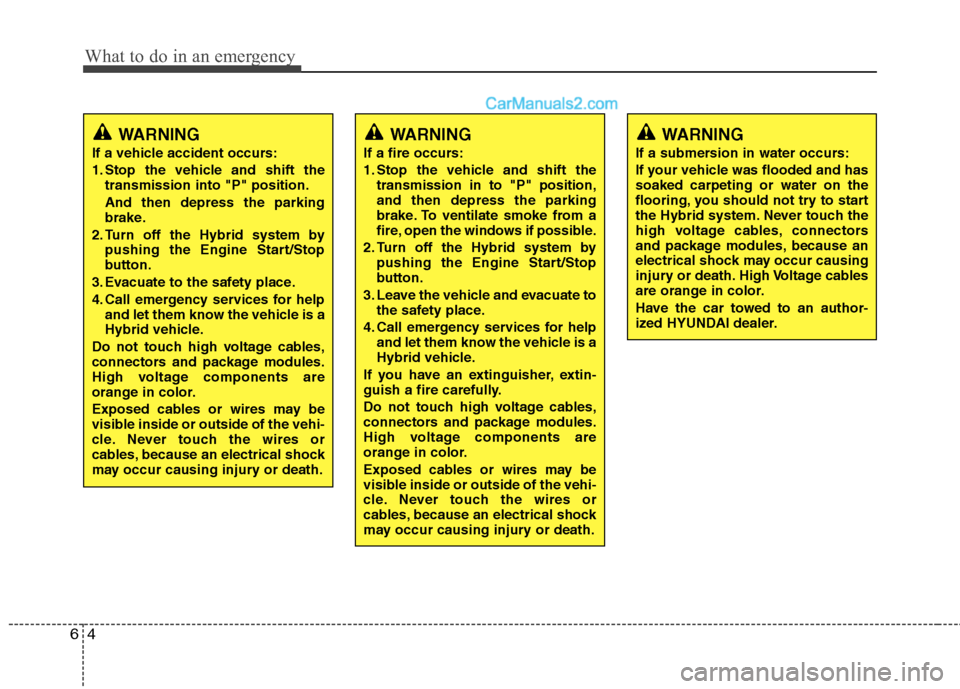
What to do in an emergency
4 6
WARNING
If a vehicle accident occurs:
1. Stop the vehicle and shift the
transmission into "P" position.
And then depress the parking
brake.
2. Turn off the Hybrid system by
pushing the Engine Start/Stop
button.
3. Evacuate to the safety place.
4. Call emergency services for help
and let them know the vehicle is a
Hybrid vehicle.
Do not touch high voltage cables,
connectors and package modules.
High voltage components are
orange in color.
Exposed cables or wires may be
visible inside or outside of the vehi-
cle. Never touch the wires or
cables, because an electrical shock
may occur causing injury or death.
WARNING
If a fire occurs:
1. Stop the vehicle and shift the
transmission in to "P" position,
and then depress the parking
brake. To ventilate smoke from a
fire, open the windows if possible.
2. Turn off the Hybrid system by
pushing the Engine Start/Stop
button.
3. Leave the vehicle and evacuate to
the safety place.
4. Call emergency services for help
and let them know the vehicle is a
Hybrid vehicle.
If you have an extinguisher, extin-
guish a fire carefully.
Do not touch high voltage cables,
connectors and package modules.
High voltage components are
orange in color.
Exposed cables or wires may be
visible inside or outside of the vehi-
cle. Never touch the wires or
cables, because an electrical shock
may occur causing injury or death.
WARNING
If a submersion in water occurs:
If your vehicle was flooded and has
soaked carpeting or water on the
flooring, you should not try to start
the Hybrid system. Never touch the
high voltage cables, connectors
and package modules, because an
electrical shock may occur causing
injury or death. High Voltage cables
are orange in color.
Have the car towed to an author-
ized HYUNDAI dealer.
Page 318 of 425
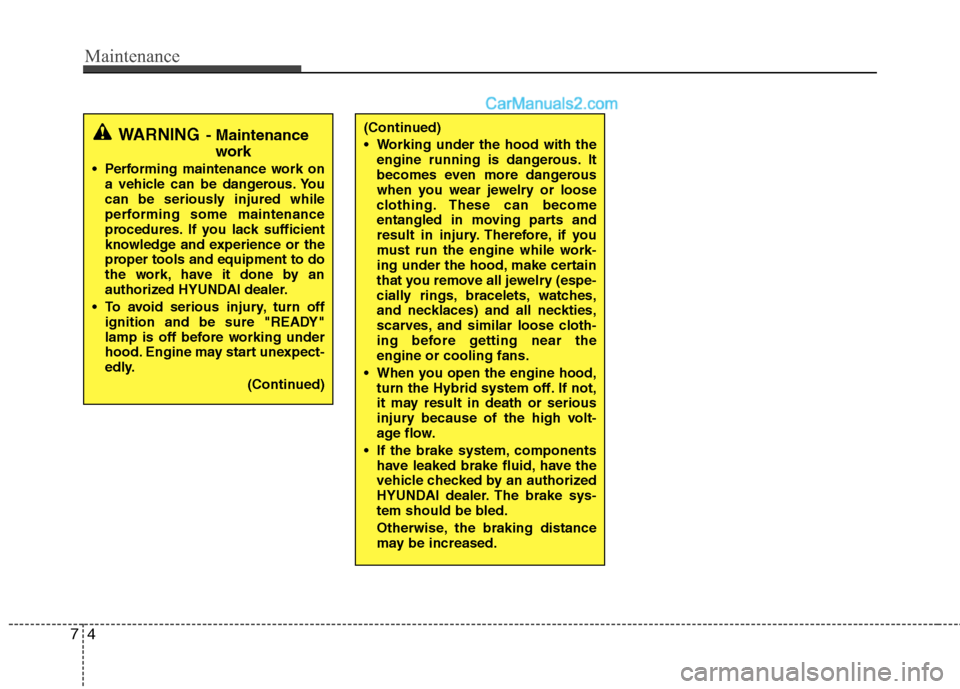
Maintenance
4 7
WARNING- Maintenance
work
Performing maintenance work on
a vehicle can be dangerous. You
can be seriously injured while
performing some maintenance
procedures. If you lack sufficient
knowledge and experience or the
proper tools and equipment to do
the work, have it done by an
authorized HYUNDAI dealer.
To avoid serious injury, turn off
ignition and be sure "READY"
lamp is off before working under
hood. Engine may start unexpect-
edly.
(Continued)
(Continued)
Working under the hood with the
engine running is dangerous. It
becomes even more dangerous
when you wear jewelry or loose
clothing. These can become
entangled in moving parts and
result in injury. Therefore, if you
must run the engine while work-
ing under the hood, make certain
that you remove all jewelry (espe-
cially rings, bracelets, watches,
and necklaces) and all neckties,
scarves, and similar loose cloth-
ing before getting near the
engine or cooling fans.
When you open the engine hood,
turn the Hybrid system off. If not,
it may result in death or serious
injury because of the high volt-
age flow.
If the brake system, components
have leaked brake fluid, have the
vehicle checked by an authorized
HYUNDAI dealer. The brake sys-
tem should be bled.
Otherwise, the braking distance
may be increased.
Page 338 of 425

Maintenance
24 7
COOLANT
Inverter coolant
The high-pressure cooling system has a
reservoir filled with year-round antifreeze
coolant. The reservoir is filled at the fac-
tory.
Check the antifreeze protection and
coolant level everyday.If it is near or at MIN, add enough coolant
between MIN and MAX and check the
cooling system for air bleed at an author-
ized HYUNDAI dealer.
Engine coolant
The high-pressure cooling system has a
reservoir filled with year-round antifreeze
coolant. The reservoir is filled at the factory.
Check the antifreeze protection and
coolant level per every day, at the begin-
ning of the winter season, and before
traveling to a colder climate.
Checking the coolant level
CAUTION
Do not mix-up the caps of engine
coolant and inverter coolant. The
cap pressure is different and if
mixed-up it could create a coolant
circulation problem for the engine
or Hybrid system.
CAUTION
When adding coolant, be careful
not to overfill.
WARNING
Removing radiator
and inverter coolant
cap
Never attempt to remove the radi-
ator and/or inverter coolant cap
while the engine is operating or
hot. Doing so might lead to cool-
ing system and engine damage
and could result in serious per-
sonal injury from escaping hot
coolant or steam.
(Continued)
OYFH071070N-1
Page 339 of 425
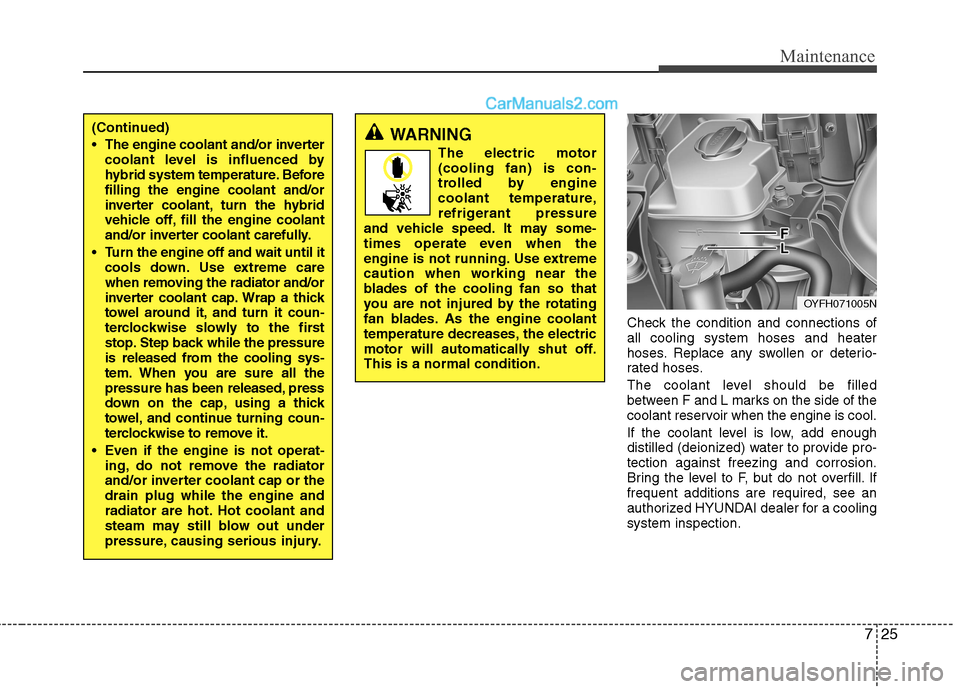
725
Maintenance
Check the condition and connections of
all cooling system hoses and heater
hoses. Replace any swollen or deterio-
rated hoses.
The coolant level should be filled
between F and L marks on the side of the
coolant reservoir when the engine is cool.
If the coolant level is low, add enough
distilled (deionized) water to provide pro-
tection against freezing and corrosion.
Bring the level to F, but do not overfill. If
frequent additions are required, see an
authorized HYUNDAI dealer for a cooling
system inspection.
OYFH071005N
(Continued)
The engine coolant and/or inverter
coolant level is influenced by
hybrid system temperature. Before
filling the engine coolant and/or
inverter coolant, turn the hybrid
vehicle off, fill the engine coolant
and/or inverter coolant carefully.
Turn the engine off and wait until it
cools down. Use extreme care
when removing the radiator and/or
inverter coolant cap. Wrap a thick
towel around it, and turn it coun-
terclockwise slowly to the first
stop. Step back while the pressure
is released from the cooling sys-
tem. When you are sure all the
pressure has been released, press
down on the cap, using a thick
towel, and continue turning coun-
terclockwise to remove it.
Even if the engine is not operat-
ing, do not remove the radiator
and/or inverter coolant cap or the
drain plug while the engine and
radiator are hot. Hot coolant and
steam may still blow out under
pressure, causing serious injury.WARNING
The electric motor
(cooling fan) is con-
trolled by engine
coolant temperature,
refrigerant pressure
and vehicle speed. It may some-
times operate even when the
engine is not running. Use extreme
caution when working near the
blades of the cooling fan so that
you are not injured by the rotating
fan blades. As the engine coolant
temperature decreases, the electric
motor will automatically shut off.
This is a normal condition.